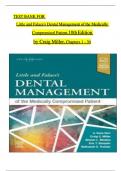Exam (elaborations)
TEST BANK For Little and Falace's Dental Management of the Medically Compromised Patient, 10th Edition by Craig Miller, Verified Chapters 1 - 30, Complete Newest Version
- Course
- Institution
- Book
TEST BANK For Little and Falace's Dental Management of the Medically Compromised Patient, 10th Edition by Craig Miller, Verified Chapters 1 - 30, Complete Newest Version TEST BANK For Little and Falace's Dental Management of the Medically Compromised Patient, 10th Edition pdf TEST BANK For Li...
[Show more]



